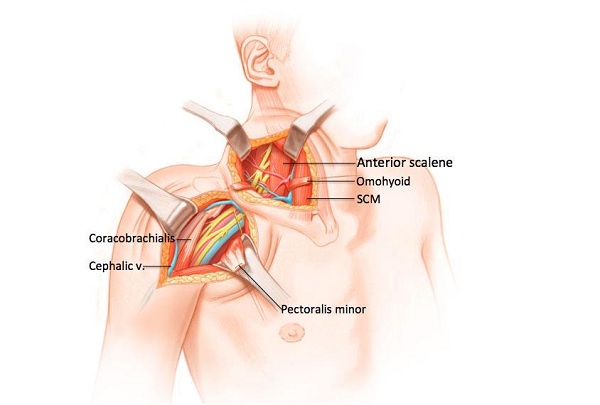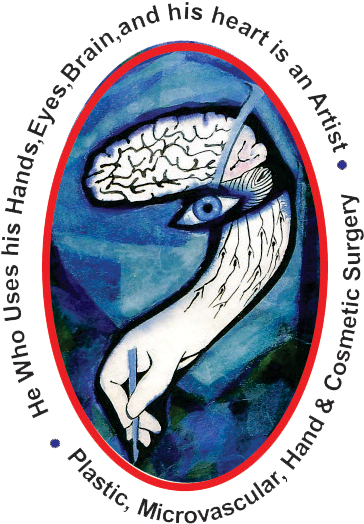Brachial Plexus Surgery
What is a brachial plexus injury?
A bundle of connected nerves in the neck region of your spinal cord sends branches down into your chest, shoulders, arms, and hands. This group of nerves is called the brachial plexus. These nerves control the motions of your wrists, hands, and arms, allowing you to raise your arm, type on your keyboard, or throw a baseball.
The brachial plexus nerves are sensory, too. For instance, they let you know that the pan you just grabbed with your hand is too hot to hold.
The brachial plexus can be injured in many different ways — from pressure, stress, or being stretched too far. The nerves may also be cut or damaged by cancer or radiation treatment. Sometimes, brachial plexus injuries happen to babies during childbirth.
Brachial plexus injuries cut off all or parts of the communication between the spinal cord and the arm, wrist, and hand. This may mean that you can’t work your arm or hand. Often, brachial plexus injuries also result in total loss of sensation in the area.
The severity of a brachial plexus injury varies. In some people, function and feeling returns to normal, while others may have lifelong disabilities because they can’t use or feel a part of the arm.
Brachial plexus injuries are categorized according to how badly the nerves are damaged:
- Avulsion. The root of the nerve is completely separated from the spinal cord (the most severe type).
- Neuropraxia. The nerves are stretched (the least severe type).
- Rupture. Part of the nerve is actually torn.
- Neuroma. Scar tissue forms on the stretched nerve as it repairs itself.
- Brachial neuritis. This is a rare syndrome for which no cause can be identified. It’s also called Parsonage-Turner syndrome.
Adult Brachial Plexus
Initial evaluation is necessary to take place as early as possible (no sooner than one month after injury but no later than 3-6 months) in order to be able to provide appropriate care and interventions. An adult brachial plexus palsy is usually the result of trauma to the neck and shoulder areas. The mechanism may be a lateral traction injury to the brachial plexus nerves in the neck causing damage to the nerves and a loss of function. Outcomes depend on severity of the brachial plexus injury and the timing of intervention.
What Happens in a Brachial Plexus Palsy
The brachial plexus is a complex network of nerves extending from the neck into each arm. This nerve network controls movement and sensation in the shoulder, arm, wrist, hand and fingers. A Brachial Plexus Palsy (BPP) affects the nerves passing from the neck to the arm. These are the nerves that trigger movement from the shoulder down to the fingers. The most common cause of brachial plexus injury is stretching, compressing, or tearing of the nerves that may result in scar formation. Although some brachial plexus injuries may heal on their own, others may result in lifelong disability if not treated promptly. Depending on the type of brachial plexus injuries, symptoms can occur in the shoulder, elbow, and/or hand and fingers. These symptoms include loss of feeling, loss of motor control, limited or no active range of motion and pain.
Birth-Related (Obstetrical) Brachial Plexus Injuries
The term birth-related brachial plexus palsy (BRBPP) refers to injury noted in the perinatal period to all or a portion of the brachial plexus. [1, 2] The term obstetrical brachial plexus palsy (OBPP) has also been used but has negative implications; accordingly, other terms, such as birth-related brachial plexus injury (BRBPI), are often preferred, particularly in the United States. Injuries associated with the upper brachial plexus are classically termed Erb palsies, and those associated with the lower plexus are traditionally termed Klumpke palsies.
Questions? We got Answers!
The most common type of injury occurs when the neck is tilted while traction occurs on the other side of the neck. However, injuries are diverse including motor vehicle accidents, falls, gunshot wounds, athletic injuries (especially contact sports), and childbirth.
During childbirth, large babies may be at an increased risk for brachial plexus injuries. A quick or emergency delivery, when the baby must be forcibly pulled out, can result in a brachial plexus injury because the baby’s neck is often flexed severely in one direction. Babies in breech position (bottom end comes out first) and those whose labor lasts an unusually long time may also suffer brachial plexus injuries.
Cancer and radiation therapy can both cause brachial plexus injury. The tumor itself can invade the brachial plexus and radiation of lymph nodes in the area can also damage the nerves.
Factors that may increase your risk include:
- Motor vehicle accidents
- Sports activities, especially football
- Childbirth, especially large babies, breech position, or long labor
- Cancer and radiation therapy
Symptoms depend on where along the length of the brachial plexus the injuries occur and how severe they are.
These are common symptoms of brachial plexus injuries:
- No feeling in the hand or arm
- Inability to control or move the arm, wrist, or hand
- An arm that hangs limply
Women with sagging breasts, which is called “ptosis”, can also receive breast implants. Depending on how much the breast sags, an additional surgery may also be necessary. For breasts with nipples that droop below the lower crease of the breast, a breast lift surgery, or mastoplexy, is often required as well. This surgery will also add scars all the way around the nipple-areola unlike most breast augmentation surgeries. Without this additional surgery to remove excess skin, placement of the implant may not adequately correct the sagging.
A health care provider will examine your hand and arm and test for sensation and function to help diagnose a brachial plexus injury.
These are other diagnostic tests often used:
- Imaging tests, such as an MRI scan or CT scan
- Tests to determine nerve function and electrical activity, including a nerve conduction study and electromyogram
- X-ray of the neck and shoulder area
Some brachial plexus injuries require surgery to repair the damage. Physical therapy can help you restore function in your arms and hands and improve range of motion and flexibility in stiff muscles and joints.
Brachial plexus injuries don’t always need treatment. Some people, particularly babies with a brachial plexus birth injury, recover without any treatment, but it can take as long as several months for the injury to heal. Certain exercises can help with healing and function.
You may need regular checkups to watch the progress and healing of a brachial plexus injury. Checkups are especially important for babies and may be needed for as long as two years as the injury heals.
For severe brachial plexus injuries, prompt surgical treatment could be needed to attempt to regain function. Without it, you might have a permanent disability and be unable to use your arm or hand.
If you have a brachial plexus injury resulting in a lack of feeling, you must take special care when dealing with hot items, razors, knives, or other objects that could harm you. A brachial plexus injury can keep you from feeling any other injury to the affected area, so you may not notice that you’re hurt.
- Long term pain or sensory changes in the affected area
- Paralysis of the affected area




